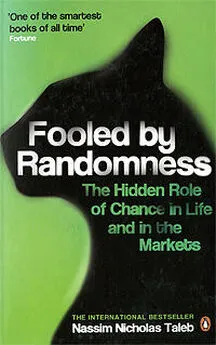Нассим Талеб - Чёрный лебедь. Под знаком непредсказуемости
- Название:Чёрный лебедь. Под знаком непредсказуемости
- Автор:
- Жанр:
- Издательство:КоЛибри
- Год:2009
- Город:Москва
- ISBN:978-5-389-00573-0
- Рейтинг:
- Избранное:Добавить в избранное
-
Отзывы:
-
Ваша оценка:
Нассим Талеб - Чёрный лебедь. Под знаком непредсказуемости краткое содержание
За одно только последнее десятилетие человечество пережило ряд тяжелейших потрясений: 11 сентября 2001 года, война в Осетии, мировой финансовый кризис. Все эти события, представляющиеся нам сейчас закономерными, казались абсолютно невозможными, пока они не произошли. Сорокадевятилетний ливанец, выпускник Сорбонны и нью-йоркский финансовый гуру Нассим Талеб называет такие непредсказуемые происшествия Черными лебедями. Он убежден: именно они дают толчок как истории в целом, так и существованию каждого отдельного человека. И чтобы преуспеть, надо знать, как с ними обращаться. Сразу после выхода этой книги автор блестяще продемонстрировал свою «не-теорию» на практике: на фоне финансового кризиса компания Талеба заработала (а не потеряла!) для инвесторов полмиллиарда долларов.
Из главного еретика Уолл-стрит, который в одиночку выступил против легиона футурологов и аналитиков, Нассим Талеб превратился в фигуру, чье влияние распространяется далеко за пределы финансового мира.
Чёрный лебедь. Под знаком непредсказуемости - читать онлайн бесплатно ознакомительный отрывок
Интервал:
Закладка:
Bak, P., and K. Chen, 1991, «Self-organized criticality.» Scientific American 264:46–53.
Ball, Philip, 2004, Critical Mass: How One Thing Leads to Another. London: Arrow Books.
-, 2006, «Econophysics: Culture Crash.» Nature 441: 686–688.
Banavar, J. R., F. Colaiori, A. Flammini, A. Maritan, and A. Rinaldo, 2000, «A Topology of the Fittest Transportation Network.» Physical Review Letters 84: 4745–4748.
Barabási, Albert-Laszlo, 2002, Linked: The New Science of Networks.Boston: Perseus Publishing.
Barabási, Albert-Laszlo, and Reka Albeit, 1999, «Emergence of Scaling in Random Networks.» Science 286:509–512.
Barabási, Albert-Laszlo, Reka Albert, and H. Jeong, 1999, «Mean-field Theory for Scale-free Random Networks.» Physica A 272:173–197.
Barabási, Albert-Laszlo, and EricBonabeau, 2003, «Scale-free Networks.» Scientific American 288(5): 50–59.
Baranski, J. V., and W. M. Petrusic, 1994, «The Calibration and Resolution of Confidence in Perceptual Judgments.» Perception and Psychophysics 55: 412–428.
Barber, В. M., and T. Odean, 1999, «Trading Is Hazardous to Your Wealth: The Common Stock Investment Performance of Individual Investors.» Working Paper.
Barbour, A. D., and G. Reinert, 2000, «Small worlds.» Preprint cond-mat/0006001 at http://xxx.lanl.gov.
Bar-Hillel, M., and W. A. Wagenaar, 1991, «The perception of randomness.» Advances in Applied Mathematics 12(4): 428–454.
Baron, Jonathan, 2000, Thinking and Deciding, 3rd ed. New York: Cambridge University Press.
Barron, G., and I. Erev, 2003, «Small Feedback-based Decisions and Their Limited Correspondence to Description-based Decisions.» Journal of Behavioral Decision Making 16:215–233.
Barrow, John D., 1998, Impossibility: The Limits of Science and the Science of Limits. London: Vintage.
Barrow, John D., and Frank J. Tipler, 1986, TheAnthropic Cosmological Principle. Oxford: Oxford University Press.
Barrow-Green, June, 1996, Poincare and the Three Body Problem. History of Mathematics, Vol. n, American Mathematical Society.
Barthélémy, M., and L. A. N. Amaral, 1999, «Small-world Networks: Evidence for a Crossover Picture.» Physical Review Letters 82: 3180–3183.
Bastiat, Frédéric, 1862–1864, Oeuvres complétés de Frédéric Bastiat,6 vols. Paris: Guillaumin.
Batchelor, R. A., 1990, «All Forecasters Are Equal.» Journal of Business and Economic Statistics 8(1): 143–144.
-, 2001, «How Useful Are the Forecasts of Intergovernmental Agencies? The IMF and OECD Versus the Consensus.» Applied Economics 33(2): 225–235.
Bates, Elisabeth, 1994, «Modularity, Domain Specificity, and the Development of Language.» In D. C. Gajdusek, G. M. McKhann, and C. L. Bolis, eds., Evolution and Neurology of Language: Discussions in Neuroscience 10:1–2,136–149.
Bauman, A. O., R. В. Deber, and G. G. Thompson, 1991, «Overconfidence Among Physicians and Nurses: The 'micro certainty, macro certainty' phenomenon.» Social Science and Medicine 32:167–174.
Bayer, Hans Christian, 2003, Information: The New Language of Science. London: Orion Books, Ltd.
Bechara, A., A. R. Damasio, H. Damasio, and S. W. Anderson, 1994, «Insensitivity to Future Consequences Following Damage to Human Prefrontal Cortex.» Cognition 50:1–3, 7–15.
Becker, Lawrence C, 1998, A New Stoicism. Princeton, N.J.: Princeton University Press.
Bellamy, Edward, 1891, Cent ans apres, ou Van 2000, trad, de Panglais par Paul Rey; avec une pref. par M. Theodore Reinach. Paris: E. Dentu.
Benartzi, Shlomo, 2001. «Excessive Extrapolation and the Allocation of 401(k) Accounts to Company Stock,» Journal of Finance 56(5): 1747–1764.
Benartzi, Shlomo, and Richard Thaler, 1995, «Myopic Loss Aversion and the Equity Premium Puzzle.» Quarterly Journal of Economics 110(1): 73–92.
Bénassy-Quéré, Agnés, 2002, «Euro/dollar: tout le mondepeutse tromper.» La Lettre du CEPII 215.
Benkirane, R., 2002, La complexite, vertiges etpromesses: 18 histoires de sciences. Paris: Le Pommier.
Berger, Peter L., and Thomas Luckmann, 1966, The Social Construction of Reality: A Treatise in the Sociology of Knowledge. New York: Anchor Books.
Bernard, Andre, 2002, Rotten Rejections: The Letters That Publisher Wish They'd Never Sent. London: Chrysalis Books.
Bernard, Claude, 1878, La science experimental. Paris: J.-B. Bailliere.
Bernoulli, Daniel, 1954, «Exposition of a New Theory on the Measurement of Risk.» Econometrica 22(1): 23–36.
Bernstein, Peter L., 1996, Against the Gods: The Remarkable Story of Risk. New York: Wiley.
Berridge, Kent C, 2003, «Irrational Pursuits: Hyper-incentives from a Visceral Brain.» In I. Brocas and J. Carillo, eds., 2003.
Berry, M., 1978, «Regular and Irregular Motion, in Topics in Nonlinear Mechanics,» ed. S. Jorna, American Institute of Physics Conference Proceedings No. 46,16–120.
Bevan, Edwyn, 1913, Stoics and Sceptics. Chicago: Ares Publishers, Inc. Bewes, Timothy, 2002, Reification: or The Anxiety of Late Capitalism. London: Verso.
Bewley, Ronald A., and Denzil G. Fiebig, 2002, «On the Herding Instinct of Interest Rate Forecasters.» Empirical Economics 27(3): 403–425.
Bhalla, U. S., and R. Iyengar, 1999, «Emergent Properties of Networks of Biological Signalling Pathways.» Science 283: 381–387.
Bharat, Barot, 2004, «How Accurate are the Swedish Forecasters on GDP-Growth, CPI–Inflation and Unemployment? 1993–2001.» Brussefo Economic ReviewICahiers Economiques de Bruxelles 47, 2 Editions du DULBEA, Universite libre de Bruxelles, 249–278.
Bikhchandani, Sushil, David Hirshleifer, and Ivo Welch, 1992, «A Theory of Fads, Fashion, Custom, and Cultural Change as Informational Cascades.» Journal of Political Economy 100 (5):992–1026.
Binmore, K., 1999, «Why Experiment in Economics?» Economic Journal 109(453): 16–24.
Birnbaum, М. Н., 1983, «Base Rates in Bayesian Inference: Signal Detection Analysis of the Cab Problem.» American Journal of Psychology 96(1): 85–94.
Bjorkman, M., 1987, «A Note on Cue Probability Learning: What Conditioning Data Reveal About Cue Contrast.» Scandinavian Journal of Psychology 28: 226–232.
-, 1994, «Internal Cue Theory: Calibration and Resolution of Confidence in General Knowledge.» Organizational Behavior and Human Decision Processes 58: 386–405.
Bjorkman, M., P. Juslin, and A. Winman, 1993, «Realism of Confidence in Sensory Discrimination: The Underconfidence Phenomenon.» Perception and Psychophysics 54: 75–81.
Blake, Carole, 1999, From Pitch to Publication. London: Pan.
Blake, David, Michael Beenstock, and Valerie Brasse, 1986, «The Performance of UK Exchange Rate Forecasters.» Economic Journal 96(384):986–999.
Blaug, Mark, 1992, The Methodology of Economics, 2nd ed. Cambridge: Cambridge University Press. Bloch, Marc, 1953, The Historian's Craft. New York: Vintage Books.
Blyth, M. R. Abdelal, and Cr. Parsons, 2005, Constructivist Political Economy. Preprint, forthcoming, 2006: Oxford University Press.
Board, J., C. Sutcliffe, and E. Patrinos, 2000, «Performance of Covered Calls.» European Journal of Finance 6(1): 1–17.
Bocarra, Nino, 2004, Modeling Complex Systems. Heidelberg: Springer.
Boettke, Peter J., Christopher J. Coyne, and Peter T. Leeson, 2006, «High Priests and Lowly Philosophers: The Battle for the Soul of Economics,» a forthcoming article in the Case Western Law Review.
Boots, M., and A. Sasaki, 1999, «„Small worlds“ and the Evolution of Virulence: Infection Occurs Locally and at a Distance,» Proceedings of the Royal Society of London В266:1933–1938.
Bostrom, Nick, 2002, Anthropic Bias: Observation Selection Effects in Science and Philosophy. London: Routledge.
Bouchaud, J.-P., and M. Potters, 2003, Theory of Financial Risks and Derivatives Pricing: From Statistical Physics to Risk Management, 2nd ed. Cambridge: Cambridge University Press.
BouRDè, Guy, and Herve Martin, 1989, Les ecoles historiques. Paris: Editions du Seuil.
Bourdieu, Pierre, 1992, Les regies de I'art. Paris: Editions du Seuil.
-, 1996, Sur la television suivi de l'emprise du journalisme. Paris: Raison d'Agir.
-, 2000, Esquisse d'une theorie de la pratique. Paris: Editions de Seuil.
Bouvier, Alban, ed., 1999, Pareto aujourd'hui. Paris: Presses Universitaires de France.
Boyer, Pascal, 2001, Religion Explained: The Evolutionary Origins of Religious Thought. New York: Basic Books.
Braudel, Fernand, 1953, «Georges Gurvitch ou la discontinuite du social.» Annales E.S.C. 8: 347–361.
-, 1969, Ecrits sur Vhistoire. Paris: Flammarion.
-, 1985, La Mediterranee: Vespace et Vhistoire. Paris: Flammarion.
-, 1990, Ecrits sur Vhistoire II. Paris: Flammarion.
Braun, P. A., and I. Yaniv, 1992, «A Case Study of Expert Judgment: Economists' Probabilities Versus Base-rate Model Forecasts.» Journal of Behavioral Decision Making 5: 217–231.
Brehmer, В., and C. R. В. Joyce, eds., 1988, Human Judgment: The SJT View. Amsterdam: North-Holland.
Brender, A., and F. Pisani, 2001, Les Marches etla croissance. Economica.
Brenner, L. A., D. J. Koehler, V. Liberman, and A. Tversky, 1996, «Overconfidence in Probability and Frequency Judgments: A Critical Examination.» Organizational Behavior and Human Decision Processes 65:212–219.
Brocas, I., and J. Carillo, eds., 2003, The Psychology of Economic Decisions, Vol. 1: Rationality and Well-Being. Oxford: Oxford University Press.
Brochard, Victor, 1878, De Verreur. Paris: Universite de Paris.
-, 1888, Les sceptiques grecs. Paris: Imprimerie Nationale.
Brock, W. A., and P. J. F. De Lima, 1995, «Nonlinear Time Series, Complexity Theory, and Finance.» University of Wisconsin, Madison — Working Papers 9523.
Brock, W. A., D. A. Hsieh, and В. LeBaron, 1991, Nonlinear Dynamics, Chaos, and Instability: Statistical Theory and Economic Evidence. Cambridge, Mass.: The MIT Press.
Brockman, John, 2005, Discussion with Benoit Mandelbrot, www.edge.org
Brookes-Gunn, J., and G. Duncan, 1994, Consequences of Growing Up Poor. New York: Russell Sage.
Broughton, W., and E. W. Mills, 1980, «Resource Inequality and Accumulative Advantage: Stratification in the Ministry.» Social Forces 58:1289–1301.
Brugger, P., and R. E. Graves, 1997, «Right Hemispatial Inattention and Magical Ideation.» European Archive of Psychiatry and Clinical Neuroscience 247(1): 55–57.
Bruner, Jerome, 1994, «The 'Remembered' Self.» In Ulric Neisser and Robyn Fivush, eds., The Remembering Self: Construction and Accuracy in the Self-Narrative. Cambridge: Cambridge University Press.
-, 2002, Making Stories: Law, Literature, Life. New York: Farrar, Straus&c Giroux.
Bruner, Jerome S., and Mary C. Potter, 1964, «Interference in Visual Recognition.» Science 144(3617): 424–425.
Brunswik, E., 1952, The Conceptual Framework of Psychology. Chicago: The University of Chicago Press.
-, 1955, «Representative Design and Probabilistic Theory in a Functional Psychology.» Psychological Review 62:193–217.
Buchanan, Mark, 2001, Ubiquity: Why Catastrophes Happen. New York: Three Rivers Press.
-, 2002, Nexus: Small Worlds and the Groundbreaking Theory of Networks. New York: W. W. Norton and Company.
Budescu, D. V, I. Erev, and T. S. Wallsten, 1997, «On the Importance of Random Error in the Study of Probability Judgment. Part I: New Theoretical Developments.» Journal of Behavioral Decision Making 10:157–171.
Buehler, R., D. Griffin, and M. Ross, 2002, «Inside the Planning Fallacy: The Causes and Consequences of Optimistic Time Predictions.» In T. Gilovich, D. Griffin, and D. Kahneman, eds., 2002.
Читать дальшеИнтервал:
Закладка:










